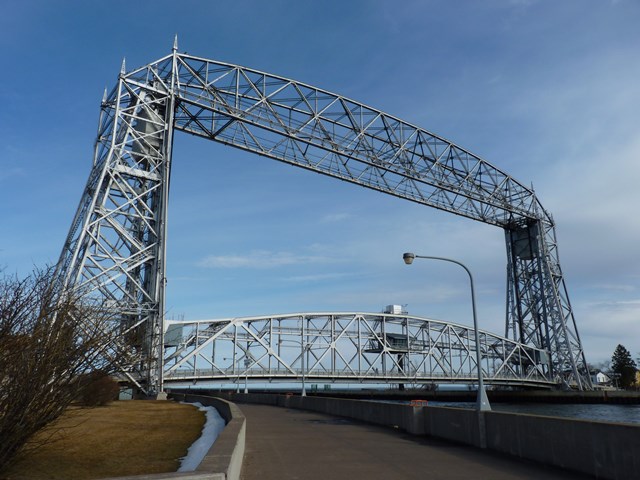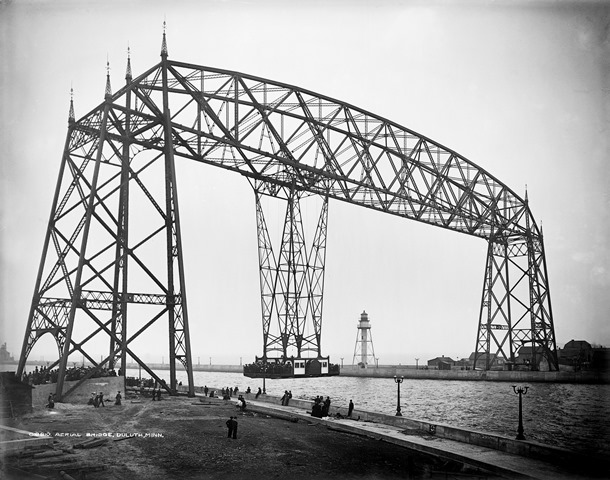We Recommend:
Bach Steel - Experts at historic truss bridge restoration.
BridgeHunter.com Phase 1 is released to the public! - Visit Now
Duluth Aerial Lift Bridge

Primary Photographer(s): Damian Entwistle, CC BY-NC 2.0, https://www.flickr.com/photos/damiavos/
Bridge Documented: 2020
Duluth: St. Louis County, Minnesota: United States
Metal 16 Panel Rivet-Connected Pennsylvania Through Truss, Movable: Vertical Lift and Approach Spans: Concrete T-Beam, Fixed
1905 By Builder/Contractor: Unknown and Engineer/Design: Thomas McGilvray of Duluth, Minnesota, Claude Allen Porter Turner of Minneapolis, Minnesota, and Harrington, Howard, and Ash of Kansas City, Missouri
2011
385.8 Feet (117.6 Meters)
501.7 Feet (152.9 Meters)
24 Feet (7.32 Meters)
1 Main Span(s) and 2 Approach Span(s)
L6116

View Information About HSR Ratings
Bridge Documentation
This bridge was originally built in 1905 as a transporter bridge. The transporter bridge was designed by Thomas McGilvray of Duluth, Minnesota. In 1930, noted engineer Claude Allen Porter Turner proposed a redesign of the structure to convert it into a traditional vertical lift bridge. The proposed lift span was designed by a firm with a long history in lift design, Harrington, Howard & Ash. This firm was formerly associated with famous enginer J. A. L. Waddell, who had originally proposed a lift bridge at Duluth in 1892, but which was rejected by the War Department, resulting in the transporter bridge being built instead. One unusual (but fortunate from a preservation perspective) aspect of the 1930 conversion to a lift bridge is that the original transporter truss span between the top of the towers was not simply demolished as one might expect. Rather, it was raised up by adding steel to the top of the original towers, which provided room for the new lifting truss span to raise fully for boats. It is possible that the original transporter towers were not stiff enough to be freestanding, which would account for why the transporter truss was spared demolition, as it would stiffen and brace the two towers. In any case, the bridge today has a unique appearance among lift bridges since it has two truss spans: the moving lift truss span from 1930, and the original 1905 transporter truss on top. As such, although the bridge no longer functions as a transporter bridge, it retains most of the original material of the 1905 transporter bridge with the exception of the gondola. The bridge is historically significant thus as both a notable vertical lift bridge and also as a remanant of the only transporter bridge surviving in the United States.
View video of bridge in operation.
View video of someone riding on the bridge as it lifts.
View video showing bridge tender house.
View live streaming cam of bridge.
View Archived National Bridge Inventory Report - Has Additional Details and Evaluation
View Historic American Engineering Record (HAER) Documentation For This Bridge
View National Register of Historic Places Nomination Form For This Bridge
View Historical Articles About This Bridge
Above: Historical photo showing bridge as originally designed.
![]()
Photo Galleries and Videos: Duluth Aerial Lift Bridge
Bridge Photo-Documentation
Original / Full Size PhotosA collection of overview and detail photos. This gallery offers photos in the highest available resolution and file size in a touch-friendly popup viewer.
Alternatively, Browse Without Using Viewer
![]()
Bridge Photo-Documentation
Mobile Optimized PhotosA collection of overview and detail photos. This gallery features data-friendly, fast-loading photos in a touch-friendly popup viewer.
Alternatively, Browse Without Using Viewer
![]()
Maps and Links: Duluth Aerial Lift Bridge
Coordinates (Latitude, Longitude):
Search For Additional Bridge Listings:
Bridgehunter.com: View listed bridges within 0.5 miles (0.8 kilometers) of this bridge.
Bridgehunter.com: View listed bridges within 10 miles (16 kilometers) of this bridge.
Additional Maps:
Google Streetview (If Available)
GeoHack (Additional Links and Coordinates)
Apple Maps (Via DuckDuckGo Search)
Apple Maps (Apple devices only)
Android: Open Location In Your Map or GPS App
Flickr Gallery (Find Nearby Photos)
Wikimedia Commons (Find Nearby Photos)
Directions Via Sygic For Android
Directions Via Sygic For iOS and Android Dolphin Browser
USGS National Map (United States Only)
Historical USGS Topo Maps (United States Only)
Historic Aerials (United States Only)
CalTopo Maps (United States Only)


